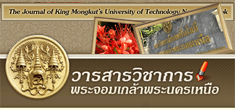Abstract
Central composite design and response surface methodology were applied to study effect of conditions in forming and to optimize a condition for manufacturing the binderless particleboard. The sample panels were produced using a hot pressing machine. From the experiment, it was found that pressing time and temperature significantly affected the internal bond strength, modulus of rupture and water absorption. With increasing the pressing time and temperature clearly decreased the water absorption but increased the internal bond strength, modulus of rupture. However, at very high pressing time and temperature it was also found that the internal bond strength and modulus of rupture gradually reduced. In addition, regression models fitted of the internal bond strength, modulus of rupture and water absorption were used to optimize the condition for manufacturing the binderless particleboard with thickness 6 mm. The optimal condition found was the pressing time 25 minutes and temperature 207 oC. Likewise, the binderless particleboard made with this condition had good mechanical and physical properties that closely matched the model predictions.
Keywords : Binderless particleboard, Rubberwood flour, Experimental design, Response surface, Hot press




